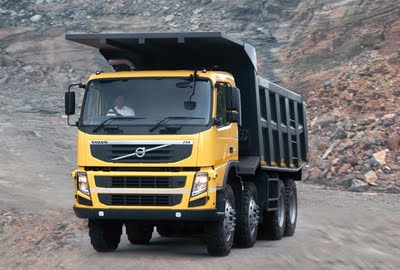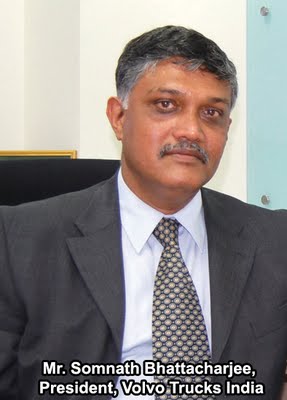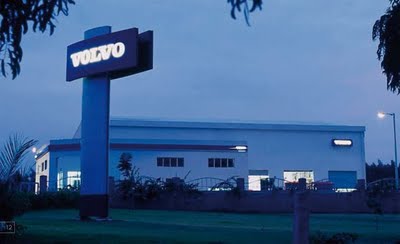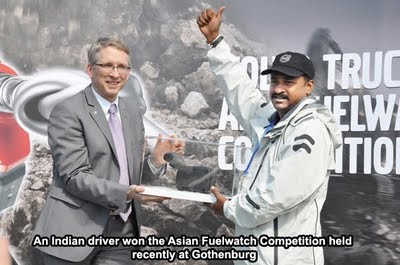 It’s been 15 years since Volvo first entered the Indian market. The Indian entity, Volvo India Private Ltd., was established in 1996 and the first truck rolled out of the production facility at Hoskote, Bangalore, in June 1998. From trucks to tippers to buses, brand Volvo has established a very strong presence in the Indian commercial vehicle segment.
It’s been 15 years since Volvo first entered the Indian market. The Indian entity, Volvo India Private Ltd., was established in 1996 and the first truck rolled out of the production facility at Hoskote, Bangalore, in June 1998. From trucks to tippers to buses, brand Volvo has established a very strong presence in the Indian commercial vehicle segment. Mr. Somnath Bhattacharjee, President, Volvo Trucks India, spoke to Motorindia in detail about the journey so far and the strategy for the future.
Mr. Somnath Bhattacharjee, President, Volvo Trucks India, spoke to Motorindia in detail about the journey so far and the strategy for the future.
The Journey so far
It’s been an interesting journey for the past 12 to 13 years. We have made significant progress in many areas by setting new standards in commercial vehicle operations. The concept of truck has gone far beyond a product. When Volvo trucks entered the Indian market there were no specifications in terms of higher performance demand in India. We had to identify select segments where we could carve out a niche for our high-performing trucks, which is today recognized as the European truck segment in India.
The market size for this segment is around 2,000 units per annum growing at the rate of 10 to 12 per cent year-on-year. We have sold 7,000 trucks so far in the last 12 to 13 years, 70 per cent of which are tippers and the balance tractor units. In 2010, we sold 1,100 trucks.
We currently offer FM 400 8X4 and FM 340 6X4 (which will be upgraded to FM 370 shortly) in the tipper segment. In the tractor segment we offer FM 400 6X4 and FH 520 6X4 model.
Our relationship with the customer is purely based on the concept of ‘total cost of ownership’. Our product is the best adapted to Indian conditions out of all the premium brands available in India today. We have a strong engineering team which is working in the local market, besides our manufacturing facility which is producing trucks for the local market.
Our trucks are adapted to the local conditions. This has made them highly reliable and high performing and also efficient in terms of fuel efficiency, turn-around time and high uptime. We have the best technology trucks and drivelines, but still adapting them to the local conditions is very crucial to get the right performance out of the truck.
Service and onsite support
On the service and onsite support front, we have been constantly raising the bar, both in terms of quality and quantity. We believe that wherever our customers go, we have to follow them. One of the key value propositions of a Volvo product is high reliability and uptime. In order to mitigate the high acquisition cost it is important that these trucks are utilized for the maximum number of working hours.
Our support structure is completely aligned to this philosophy. We have not only created world class workshops and repair facilities, but our site support mechanism is extremely unique where we have created world class infrastructure by setting up containerized workshops having a full-fledged facility with special tools to do component overhaul and truck repair.
We have more than 25 such on-site support facilities across India, and the number is steadily growing. Be it a project for construction of hydel power project, coal mines, lignite mine and special construction project, our philosophy is to get closer to the customer to provide all the part and service support, so that we can ensure uptime of our customer vehicles and keep the trucks in the best working condition to ensure they deliver the best in terms of fuel economy and component life.
Competence development
In the last 12-13 years we have grown both in terms of geographical locations and volumes. One of the key challenges was to maintain the competence balance in the system. We have in India the largest talent pool, but the equipments are very specialized, and hence to develop competence on our product and continuously refresh those is always a key priority.
Volvo has a global competition called Vista, which encourages competence development. We have a similar program in India which encourages competence development among technicians. We want to encourage the technicians to learn more, and eventually these learnings are translated and delivered to the customer’s trucks in terms of quality service and optimizing the repair cost. The whole objective is to create the learning culture, so that we are able to constantly upgrade our knowledge and competence which eventually results in better customer satisfaction.
Driver training
We are working on creating an environment for improved performance even within the customer’s organization. In fact, fuel in the Indian context remains the key contributor of cost, close to 45 to 50 per cent, depending on the application. Our truck specifications are best adapted to local conditions and hence the most fuel-efficient in its class, delivering at least four to five per cent better mileage than the nearest competition.
But that’s not enough; our global experience shows that driver development is crucial to deliver the best performance in fuel economy and optimizing the repair cost for trucks. Taking cue from Volvo’s global experience, we ran a fuel watch competition. In the first event, nearly 75 drivers were nominated from various customer organisations. Eventually the Asian finals happened at Gothenburg in March, and an Indian driver won the competition.
Why are we doing this? It’s a constant engagement with our customers and our own teams to sensitise on the key improvement parameters which eventually improves efficiency and the profitability for our customers. This competition has revealed that between the best and the weakest driver, under the same test conditions, the difference in fuel economy was as high as 70 per cent.
So far we have trained at our driver training centre in Bangalore more than 26,000 drivers. The program is not just on driving aspects but also on health, environment and, most importantly, on how to improve the overall performance level of trucks. To take it to the next level, we have recruited regional driver trainers to follow-it up. We are actively engaged with customers through these regional driver trainers who conduct on-the-job refresher training courses at the site. This helps in improving the overall performance, quality and efficiency of the drivers. Customers are looking for more participative relationship with suppliers like us, hence we bring the best practices and processes on table. Our current engagement with customers is at an extremely matured level. We are working with each other to drive progress in the industry in India.
To take it to the next level, we have recruited regional driver trainers to follow-it up. We are actively engaged with customers through these regional driver trainers who conduct on-the-job refresher training courses at the site. This helps in improving the overall performance, quality and efficiency of the drivers. Customers are looking for more participative relationship with suppliers like us, hence we bring the best practices and processes on table. Our current engagement with customers is at an extremely matured level. We are working with each other to drive progress in the industry in India.
Success in the tipper segment
We have sold over 7,000 trucks till date, 70 per cent of them are tippers and the remaining tractor units. The key reason why we have more tippers than tractor units is that in a controlled working environment our trucks can be utilised for much longer hours. When the acquisition cost is higher than the mass market products, we have to create an environment for the assets to be utilised the maximum number of hours. In the mining and construction industry we are able to achieve but not in the on-road trucks, as the average speeds are still not more 35 to 40 km per hour. Therefore, even if the trucks are capable for faster turn-around, because of the external environment, the utilisation comes down, which puts a hurdle on the profitability of our customers.
In the mining and construction industry, our trucks are able to average 20 to 22 hours of working everyday. We provide 24/7 service at our customer’s doorstep ensuring uptime of our customer vehicles.
Many of our customers own more than 100 of our tippers. This high rate of repeat orders, which is excess of 70 per cent, clearly proves that our engagement is continuously improving, and it’s a win-win situation for us and our customers who also see a lot of value associating with our brand and driving progress in their business.
In the segments that we are operating, the specification demands are very high. In the open cast mining, the depths are as high as 100 to 120 meters. Torque on wheels is a very critical factor, and our trucks are designed and adapted to negotiate through these mines. We offer a FM 400, 400 hp, 8X4 tipper tipper for deep mining applications. Product development for this segment needs huge resource and time, and therefore in these specialized segments, European trucks will have an edge because we have the right specs.
In a nutshell, there will be more and more high quality products which will be emerging in the next three-four years. We are likely see a large transformation in terms of truck specifications, higher horsepower, quality and performance levels. But when it comes to high performance segments like mining and construction, they still need very high specification trucks, and I do not foresee too many Indian products can actually compete with the European ones as they require very focused product development involving huge resource.
Since India doesn’t offer a large market for these products, standalone product development of trucks of this specification may not be commercially viable, and therefore European products adapted to Indian conditions would be a better strategy. New applications
New applications
As the high performance culture is gaining momentum in organisations, we see large opportunities in specialized haulage segment, mineral transportation, etc. We are actively working on adapting our products to those segments which require high performance trucks but yet do not have the right offering today in the market.
Instead of operating too many smaller trucks, the operators are moving towards large capacity and more powerful multi-axle variants, which can do the work more efficiently. We are looking at large rigid trucks on 8X4 platform for high volume cargo. We also offer our rigid trucks for construction-specific applications like high capacity boom pumps, concrete mixers and fire and rescue trucks.
We are also looking at increasing our offering in the over dimensional cargo (ODC) segment in which we have leadership position. With large-scale infrastructure development, and especially power plants and large construction projects (As per the 12th Plan, India will add 10,000 to 12,000 megawatt of power every year). This will create huge demand for plant and machinery transportation, and there you need very specialized trucks with high capacity, high torque.
In the tractor segment, we offer FH400 HD, FM 400 standard tractor and FH 520. We also offer our tractor models for special Defence applications in the research and development organisations and also in the aviation refuelling segment, where safety is key requirement.
Increasing competition
Entry of competitive European brands is a welcome move as this will help expand the market. We are confident of maintaining and managing our competitive advantage. Our product development and engagement with the Indian customer and the value proposition we offer is much beyond the truck. We feel our engagement levels and overall contribution to the industry has matured and grown over the last 12 years, and we have very strong competence and talent.
The ability to adapt the product is our key competence and all manufacturers will have to go through the learning curve. The distribution and overall approach towards optimizing the total cost of ownership will be a differentiating factor. Making a good product is not enough, creating an environment and engagement to demonstrate to the customer that he can achieve the best will be the key success factor.
Our current engagement through all our initiatives, whether it is the area of competence development, driver development, creating world class infrastructure and facility together with a very strong talented, motivated and inspired team takes very long hours of learning and experience. That’s our key success factor and we will be able to maintain our competitive advantage.
With the emergence of new brands, I see more opportunities for everyone as the market is bound to expand.